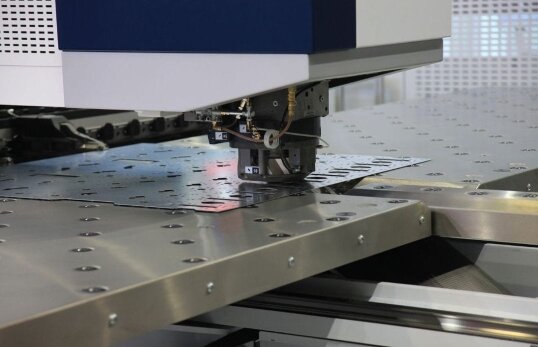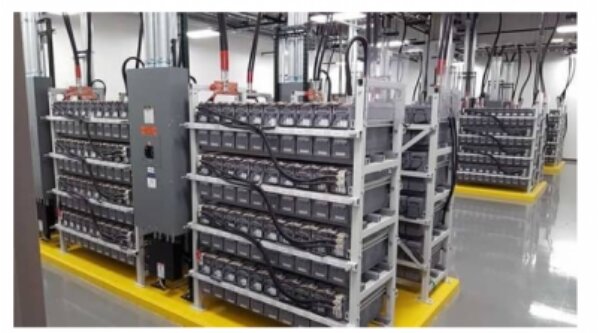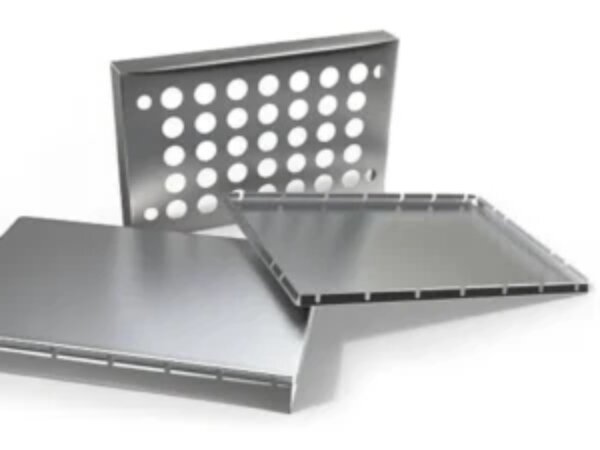No fabrico de metais, o corte e a dobragem são muitas vezes os aspectos mais importantes. Mas o que realmente molda a força e o aspeto de uma peça vem depois desses passos - o acabamento. Um tratamento de superfície adequado pode transformar uma peça normal numa peça que resiste à ferrugem, ao desgaste e aos efeitos de anos de utilização. Sem ele, mesmo os componentes bem fabricados podem falhar prematuramente.
O acabamento e o revestimento de chapas metálicas protegem as peças de ambientes agressivos. Melhoram o desempenho, melhoram o aspeto e mantêm a fiabilidade das peças ao longo do tempo. Quer esteja a conceber peças, a comprar componentes ou a gerir a produção, a seleção do acabamento correto pode ter um impacto significativo na durabilidade e na qualidade.
Este artigo examina vários métodos padrão de acabamento e revestimento, incluindo revestimento em pó, anodização, galvanoplastia e passivação. Cada método tem as suas próprias vantagens. Ao compreender como os diferentes acabamentos afectam a força, a resistência à corrosão e o aspeto, pode fazer escolhas mais informadas que melhoram o desempenho e a vida útil do seu produto.
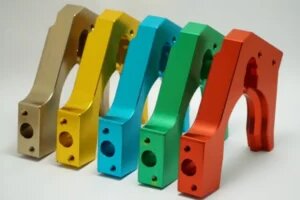
O que é o acabamento de chapas metálicas?
O acabamento de chapas metálicas é a fase final do fabrico que melhora o aspeto, a resistência e o desempenho de uma peça. Utiliza métodos mecânicos, químicos ou electroquímicos para tratar a superfície do metal. Estes processos removem pequenas falhas, suavizam áreas ásperas e preparam as peças para revestimentos ou pintura. O acabamento também adiciona uma camada protetora que ajuda a evitar a ferrugem, a corrosão e o desgaste da superfície.
Um bom acabamento pode transformar o metal nu numa peça pronta a ser utilizada a longo prazo. Pode parar a oxidação em condições húmidas ou ao ar livre e reduzir a fricção entre as peças móveis. Os acabamentos também tornam as peças mais fáceis de limpar e ajudam-nas a manter o seu aspeto durante mais tempo.
Tipos comuns de acabamento de chapas metálicas
Cada método de acabamento tem os seus próprios pontos fortes, dependendo da função da peça e do ambiente de trabalho. Abaixo estão alguns dos acabamentos mais populares e eficazes utilizados para peças de chapa metálica.
Jateamento de contas
Jateamento de esferas utiliza contas de vidro delicadas e ar comprimido para limpar e alisar superfícies metálicas. Este processo remove a ferrugem, a oxidação e as marcas de maquinagem, mantendo as dimensões exactas da peça. Cria uma superfície mate ou acetinada com uma rugosidade de cerca de Ra 1,0-3,0 μm, tornando-a uma base adequada para posterior revestimento ou pintura.
É frequentemente utilizada em aço inoxidável, alumínio e aço macio. A decapagem com grânulos melhora a aderência do revestimento e proporciona às peças um aspeto limpo e uniforme que oculta pequenas imperfeições da superfície. É uma excelente escolha quando é necessário um aspeto consistente e uma textura fina.
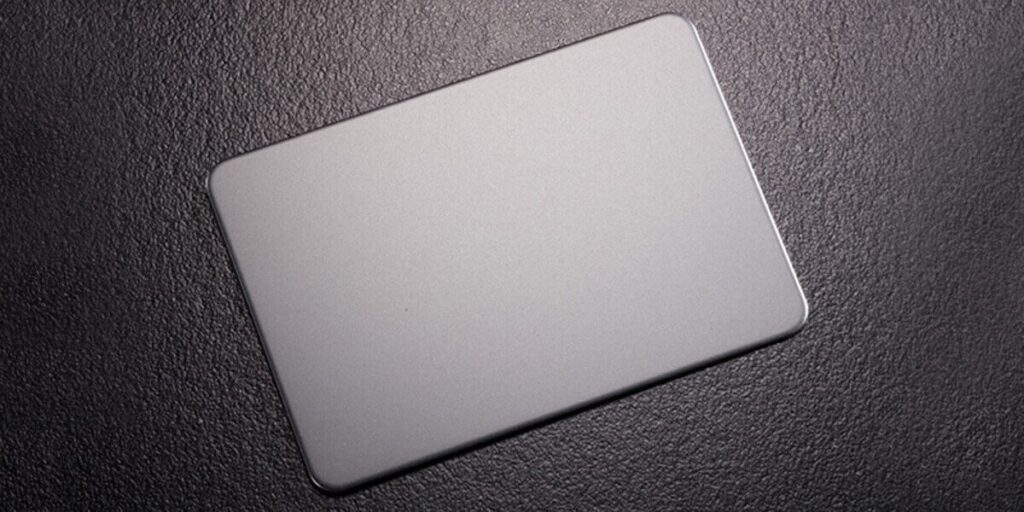
Revestimento em pó
Revestimento em pó envolve a pulverização de partículas de pó carregadas sobre uma superfície metálica aterrada, curando-as depois num forno a 180-200°C. O pó fundido forma uma película contínua e duradoura com uma espessura entre 60 e 120 μm.
Este revestimento oferece uma excelente proteção contra a corrosão, impactos e danos causados pelos raios UV, tornando-o adequado para aplicações interiores e exteriores. As peças com revestimento em pó mantêm a sua cor e brilho durante anos, apresentando um mínimo de desvanecimento ou descamação. Com inúmeras cores e texturas à escolha, este acabamento é amplamente utilizado em armários, mobiliário e peças de maquinaria que necessitam de resistência e atração visual.
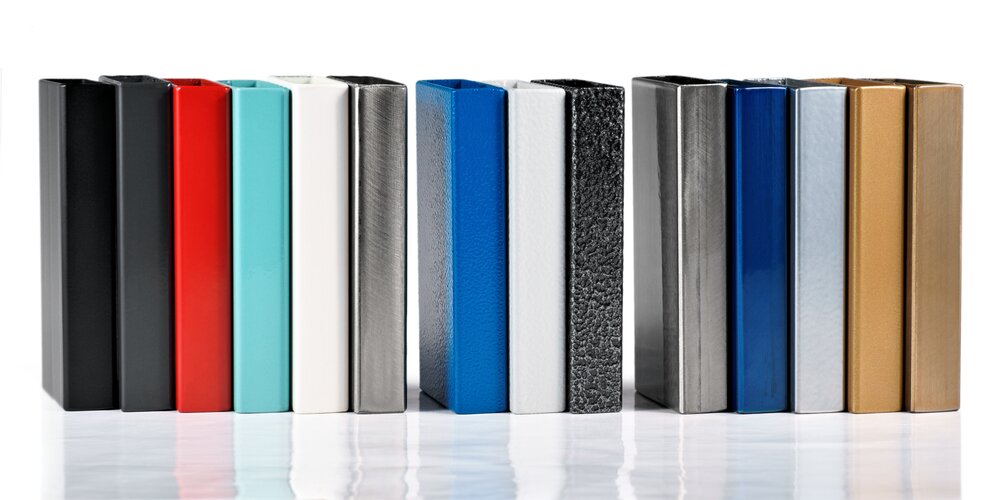
Pintura
Pintura adiciona uma fina camada de 30-50 μm de revestimento líquido para proteger o metal e dar cor. A superfície é limpa e, por vezes, tratada com uma camada de fosfato para melhorar a aderência da tinta. As peças são depois cozidas a 120-150°C para curar a tinta e aumentar a sua durabilidade.
As diferentes tintas são utilizadas para diferentes fins:
- Tinta epoxi oferece uma forte resistência química e é adequado para máquinas industriais.
- Tinta acrílica seca rapidamente e funciona bem para mobiliário de interior ou expositores.
- Tinta de poliuretano resiste à luz solar e à chuva, tornando-o ideal para aplicações no exterior.
A pintura é flexível em termos de opções de cor e acabamento, e económica para protótipos ou pequenos lotes. Embora não seja tão resistente como o revestimento a pó, proporciona uma superfície atraente, fácil de limpar e com uma sólida proteção contra as intempéries.
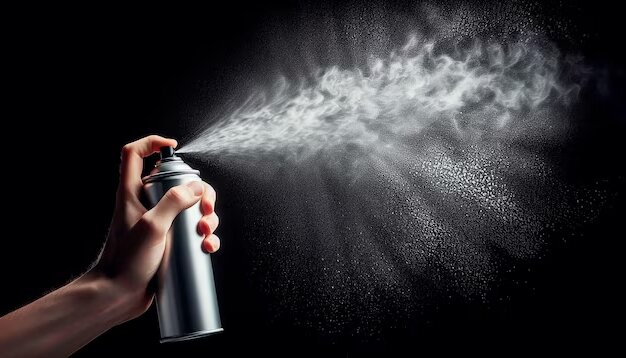
Galvanoplastia
Galvanoplastia utiliza uma corrente eléctrica para revestir uma peça com uma camada fina de outro metal, como o zinco, o níquel ou o crómio. O revestimento tem normalmente uma espessura de 2-25 μm.
- Zincagem proporciona resistência à corrosão e um aspeto prateado brilhante.
- Revestimento de níquel acrescenta dureza e resistência ao desgaste.
- Cromagem proporciona um acabamento espelhado com elevada durabilidade.
As peças galvanizadas são normalmente utilizadas em produtos automóveis, electrónicos e decorativos, em que tanto a aparência como o desempenho são essenciais.
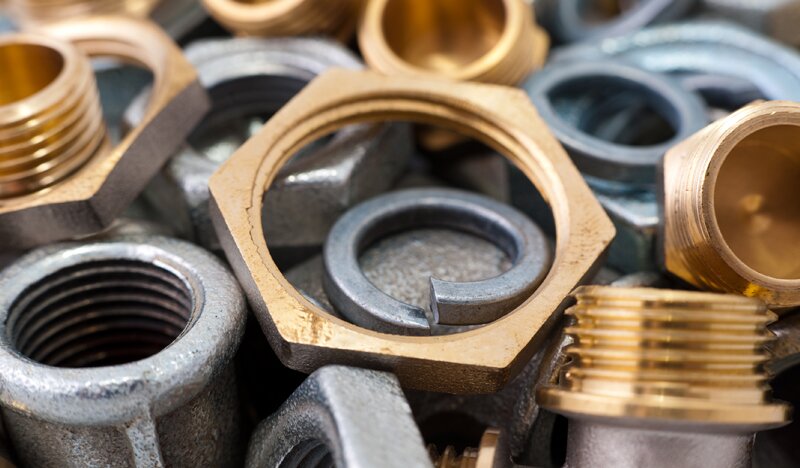
Anodização
Anodização é utilizado principalmente no alumínio para melhorar a resistência à corrosão e a dureza da superfície. A peça de alumínio é colocada num banho de ácido e uma corrente eléctrica forma uma camada de óxido fortemente ligada com uma espessura de 10-100 μm.
O alumínio anodizado pode ser tingido numa variedade de cores. Como o corante é absorvido pela camada de óxido, não lasca nem descasca. Depois, a superfície é selada em água quente para fechar os poros e fixar a cor.
- Anodização tipo II (ácido sulfúrico) é comum para uso doméstico e arquitetónico.
- Anodização tipo IIItambém conhecida como anodização dura, cria uma camada mais espessa e dura para peças aeroespaciais e industriais.
As peças anodizadas também oferecem um forte isolamento elétrico, tornando-as adequadas para caixas, dissipadores de calor e componentes electrónicos.

Passivação e película química
A passivação aumenta a resistência à corrosão do aço inoxidável, removendo o ferro livre e as impurezas da superfície. Forma uma película de óxido fina e invisível sem alterar o aspeto da peça.
No caso do alumínio, um revestimento de película química, como a conversão de cromato, proporciona uma proteção semelhante. Estes revestimentos são frágeis, medindo normalmente menos de um μm, e mantêm a condutividade eléctrica enquanto resistem à oxidação. Ambos os tratamentos são normalmente utilizados em caixas e conjuntos eléctricos onde a condutividade e a resistência à corrosão são essenciais.
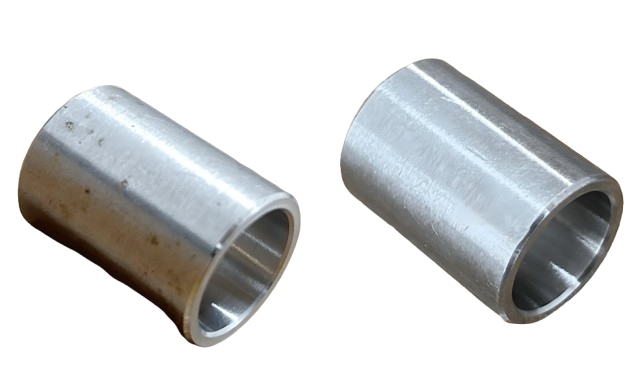
Revestimento eletrônico
E-coating, também conhecido como revestimento electroforéticoaplica a tinta uniformemente através de um campo elétrico. A peça é submersa num banho de tinta à base de água, carregada e depois cozida a 160-190°C. O revestimento final tem normalmente uma espessura de 20-35 μm, cobrindo mesmo formas complexas e cantos apertados.
O E-coating oferece acabamentos lisos e brilhantes com excelente resistência à corrosão. É amplamente utilizado na produção automóvel e de electrodomésticos porque proporciona uma cobertura consistente, uma forte aderência e resistência a lascas e ao desbotamento.
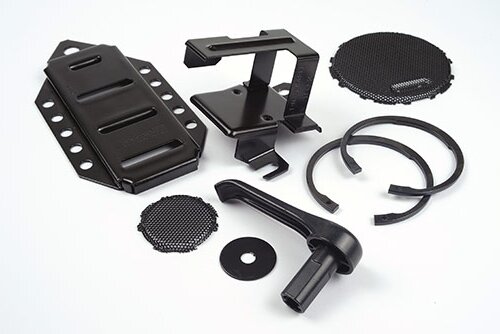
Enegrecimento a quente
Enegrecimento a quente, também designado por revestimento de óxido negroO óxido de ferro forma uma fina camada negra no aço ou no ferro. As peças são mergulhadas numa série de banhos químicos aquecidos que criam uma camada de óxido com cerca de 1 μm de espessura.
Este acabamento proporciona uma proteção ligeira contra a corrosão, reduz o brilho e dá um aspeto escuro uniforme. É normalmente utilizado para ferramentas, fixadores e peças de precisão que requerem um aspeto limpo e profissional, mantendo as dimensões apertadas.
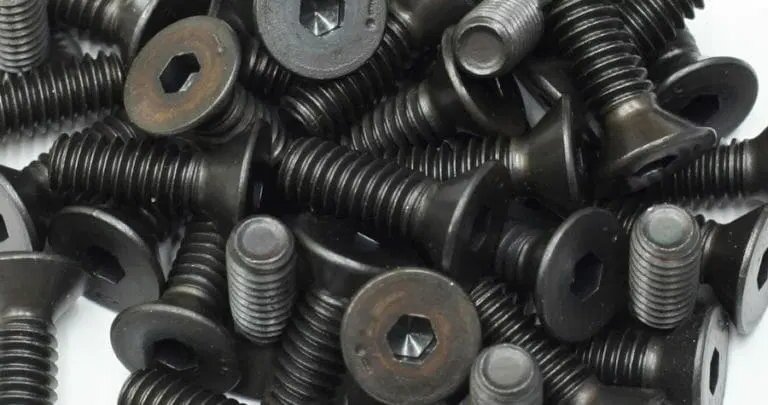
Como o acabamento de chapas metálicas melhora o desempenho?
Acabamento da superfície faz mais do que dar um bom aspeto às peças - tem um efeito direto no seu desempenho e na sua duração. Cada tipo de tratamento de superfície desempenha um papel crucial na proteção da peça e na minimização dos custos a longo prazo.
Resistência à corrosão e ao desgaste
As peças metálicas enfrentam frequentemente condições adversas, tais como humidade, produtos químicos ou fricção. Sem um acabamento adequado, estes factores podem causar ferrugem, oxidação ou desgaste da superfície. Os acabamentos como o revestimento a pó, a anodização e a galvanoplastia criam uma camada protetora que evita estes problemas. Por exemplo, uma caixa de aço com revestimento em pó pode resistir às condições atmosféricas exteriores durante anos, enquanto o alumínio anodizado permanece estável em ambientes húmidos ou marítimos.
Os acabamentos também protegem contra o desgaste mecânico provocado por contactos ou movimentos repetidos. A anodização dura e a niquelagem tornam as superfícies mais complicadas e mais resistentes a riscos ou à abrasão. Ao reduzir a corrosão e o desgaste, o acabamento de superfícies ajuda a prolongar a vida útil da peça e reduz os custos de manutenção - uma vantagem fundamental tanto na produção como na utilização quotidiana.
Benefícios estéticos e de marca
Um acabamento de qualidade confere a um produto um aspeto profissional e de elevado valor. Os revestimentos lisos e uniformes ajudam as peças a parecerem precisas e duradouras, o que reforça a confiança do cliente na marca. Os acabamentos, como o revestimento a pó e a pintura, estão disponíveis numa vasta gama de cores e texturas, proporcionando às empresas a flexibilidade necessária para corresponder aos seus objectivos de marca e design.
Para os produtos de consumo, o aspeto e o toque são tão importantes como a função. Uma superfície acetinada ou um revestimento em pó brilhante transmite qualidade e atenção aos pormenores. Para além da aparência, os acabamentos também evitam o desbotamento e a descoloração, ajudando os produtos a manter o seu aspeto limpo ao longo do tempo.
Desempenho elétrico e térmico
Alguns acabamentos melhoram a capacidade de uma peça para lidar com eletricidade ou calor. A galvanoplastia de níquel ou cobre aumenta a condutividade eléctrica, tornando-a ideal para utilização em terminais, conectores e componentes electrónicos. Por outro lado, o alumínio anodizado proporciona isolamento onde as peças precisam de bloquear o fluxo de corrente, como caixas ou dissipadores de calor.
Os acabamentos também podem melhorar a transferência de calor. Os revestimentos protectores que reduzem a oxidação mantêm um desempenho térmico estável, especialmente em componentes como fontes de alimentação ou módulos LED. Selecionar o acabamento certo com base nas necessidades eléctricas ou térmicas garante que a peça funciona de forma segura e eficiente em condições reais.
Como escolher o acabamento de chapa metálica correto?
Cada peça tem necessidades de desempenho diferentes e o melhor acabamento depende do local e da forma como vai ser utilizada. A escolha correta melhora tanto a função como o aspeto. Eis os principais pontos a considerar ao selecionar um acabamento.
Como fazer corresponder o acabamento ao material?
Os diferentes metais reagem de forma diferente aos métodos de acabamento. O material de base determina quais os tratamentos que irão aderir bem e proporcionar uma proteção duradoura.
O alumínio funciona melhor com anodização, que aumenta a dureza e oferece uma gama de opções de cores. Também combina bem com revestimento em pó ou pintura quando é necessária uma resistência extra à corrosão ou decoração.
O aço inoxidável beneficia mais da passivação e da granalhagem, que limpam e protegem sem reduzir a sua resistência natural à corrosão. Para um aspeto mais escuro ou brilhante, pode ser utilizado o revestimento eletrónico ou o electropolimento.
O aço macio necessita de uma proteção mais forte, uma vez que enferruja facilmente. A zincagem, o revestimento a pó e a pintura são escolhas comuns para formar uma barreira sólida contra a humidade e a oxidação.
O cobre e o latão são frequentemente utilizados com revestimentos transparentes ou niquelagem para evitar o embaciamento, mantendo a sua cor metálica. Uma vez que cada metal reage de forma diferente ao seu ambiente, a seleção de um acabamento compatível garante um desempenho duradouro e um aspeto atraente.
| Acabamento | Aço carbono | Aço inoxidável | Alumínio | Ligas de cobre | Aço galvanizado |
|---|---|---|---|---|---|
| Óxido Negro | Adequado para ferramentas, acessórios e fixadores; confere uma ligeira resistência à corrosão. | Não é normalmente utilizado. | Não é adequado. | Não é adequado. | Não é adequado. |
| Galvanoplastia | Utilizado para revestimentos de zinco, níquel ou crómio para melhorar o aspeto e a proteção contra a corrosão. | Normalmente desnecessário devido à resistência natural à corrosão. | Não é comummente utilizado. | Frequentemente utilizado para acabamentos decorativos ou protectores em níquel e crómio. | Não recomendado. |
| Anodização | Não é adequado. | Não é adequado. | Comum para peças de alumínio; melhora a resistência ao desgaste e a estabilidade da cor. | Não é adequado. | Não é adequado. |
| Pintura | Acabamento comum e de baixo custo; confere proteção contra a corrosão e as intempéries. | Funciona como uma camada de barreira extra; cores personalizáveis. | Acabamento flexível para protótipos e produtos de consumo. | Oferece resistência à cor e à oxidação. | Frequentemente utilizado para peças exteriores que necessitam de uniformidade visual. |
| Revestimento em pó | Fornece um revestimento durável e resistente ao impacto; utilizado para máquinas e peças exteriores. | Ideal para aplicações industriais que requerem durabilidade e aparência. | Acabamento decorativo popular com forte proteção contra a corrosão. | Aplicado para uma proteção duradoura da cor. | Aumenta a resistência à corrosão em peças pré-revestidas. |
| Passivação | Não aplicável. | Melhora a resistência à corrosão e a estabilidade da superfície. | Não é adequado. | Não é adequado. | Não é adequado. |
| Polimento | Aumenta a suavidade da superfície e melhora a aparência. | Produz um acabamento espelhado ou escovado. | Melhora a refletividade e a suavidade. | Utilizado para fins decorativos. | Melhora o aspeto e a limpeza da superfície. |
| Jato de areia | Limpa a oxidação e prepara as superfícies para o revestimento. | Remove as incrustações e melhora a aderência da superfície. | Cria uma textura mate uniforme. | Utilizado para limpar e dar textura antes do acabamento. | Prepara a superfície para pintura ou revestimento a pó. |
Qual é o ambiente operacional da peça?
O ambiente tem um impacto significativo no tempo de vida de um peixe. As peças utilizadas em ambientes húmidos, salgados ou quimicamente ricos requerem uma elevada resistência à corrosão. O revestimento a pó e a anodização são adequados para aplicações no exterior ou perto da água. Para aplicações em interiores, a galvanoplastia ou a passivação fornecem normalmente proteção suficiente.
Quando as peças são expostas ao calor, à fricção ou ao contacto com outros componentes, selecione acabamentos que resistam ao desgaste mecânico. Para equipamento médico ou de qualidade alimentar, os acabamentos lisos e laváveis, como o aço inoxidável polido ou o alumínio anodizado, são ideais.
Quais são as suas necessidades de desempenho?
Cada acabamento oferece diferentes vantagens mecânicas e funcionais. Para resistência à abrasão, utilize anodização dura ou niquelagem. Para a condutividade eléctrica, escolha a zincagem ou o revestimento de película química, que mantém um bom contacto entre as superfícies metálicas.
Se o seu objetivo é a consistência visual, o E-coating e o revestimento a pó proporcionam uma cor e um brilho uniformes. As peças móveis beneficiam de superfícies mais lisas que reduzem o atrito e evitam o desgaste prematuro. A correspondência do acabamento com a finalidade da peça ajuda a manter o desempenho e a fiabilidade ao longo do tempo.
Quais são as suas restrições orçamentais e de calendário?
O custo e o calendário orientam frequentemente as decisões de acabamento. A pintura por pulverização e a granalhagem são económicas e rápidas, o que as torna adequadas para protótipos ou pequenas séries de produção. O revestimento em pó e o revestimento eletrónico requerem tempos de preparação mais longos, mas são mais eficientes para a produção em massa.
Se o tempo for limitado, escolha acabamentos com tempos de cura ou secagem curtos. Para poupanças a longo prazo, investir em acabamentos duradouros pode reduzir os custos futuros de manutenção e substituição.
Que aspeto pretende obter?
O acabamento da superfície define o aspeto e o toque do produto. Um acabamento mate ou escovado confere um estilo industrial, enquanto o cromado ou o revestimento em pó brilhante criam um aspeto moderno e sofisticado.
A cor, o brilho e a textura influenciam a forma como os clientes percepcionam a qualidade. Os designers selecionam frequentemente acabamentos que correspondem à imagem da sua marca, ao mesmo tempo que estabelecem um equilíbrio entre desempenho e custo.
Capacidades de acabamento e revestimento da Shengen
Na Shengen, apoiamos projectos desde o protótipo até à produção. Oferecemos um conjunto completo de serviços de acabamento e revestimento. A nossa prioridade é uma qualidade estável e prazos de entrega rápidos.
Temos vários opções de acabamento interno para manter o controlo e a velocidade:
- Revestimento em pó: Oferecemos uma variedade de texturas e níveis de brilho. O revestimento adere bem e dura no exterior. Adequa-se a armários, caixilhos e peças estruturais.
- Pintura: Combinamos as cores rapidamente para protótipos e pequenas séries. O acabamento é suave e limpo.
- Jato de esferas e jato de areia: Limpamos e alisamos a superfície antes de a revestir. A textura mate ajuda a tinta ou o pó a aderir melhor.
- Polimento e escovagem: Melhoramos o aspeto, removemos riscos finos e obtemos um acabamento acetinado ou espelhado.
Também estabelecemos parcerias com lojas de tratamento de superfícies de confiança para necessidades especiais:
- Anodização (tipos II e III): Melhoramos o alumínio com uma maior resistência ao desgaste e à corrosão. Oferecemos cores transparentes, pretas e personalizadas.
- Galvanoplastia: Adicionamos zinco, níquel ou crómio para proteção ou melhoria do aspeto. Também melhoramos a condutividade quando necessário.
- E-Coating: Proporcionamos uma película suave e uniforme em formas complexas. O resultado tem um aspeto premium e consistente.
- Passivação: Tratamos o aço inoxidável para melhorar a sua resistência à corrosão sem alterar o seu aspeto ou a textura da superfície.
Pode enviar-nos os seus desenhos e especificações. A nossa equipa analisará o seu material, os seus objectivos e avaliará o seu orçamento. Prepararemos um orçamento preciso com prazos de entrega e notas técnicas.
Os nossos engenheiros podem ajudá-lo a comparar opções. Podemos explicar quando é que o revestimento em pó supera a anodização, bem como quando é que outro acabamento é mais adequado. Partilhe os detalhes da sua peça e forneceremos uma consulta gratuita sobre tratamento de superfície e preços.
Perguntas frequentes sobre o acabamento de chapas metálicas
Aqui estão as respostas a algumas perguntas comuns sobre o acabamento e revestimento de superfícies de chapa metálica. Estes detalhes podem ajudá-lo a planear o seu processo de acabamento com expectativas claras.
Posso personalizar a cor ou a textura do meu acabamento?
Sim. Oferecemos personalização de todas as cores de acordo com as normas RAL ou Pantone. O revestimento em pó, a pintura e a anodização podem alcançar uma vasta gama de cores e texturas de superfície - desde acabamentos suaves e mate até ao brilho. Para correspondência com a marca, podemos efetuar testes de amostras antes da produção para confirmar a precisão e consistência da cor.
Qual é a espessura normal dos revestimentos aplicados?
A espessura do revestimento varia consoante o tipo de acabamento e as necessidades funcionais:
- Revestimento em pó: 60-120 μm
- Pintura por pulverização: 30-50 μm
- Anodização: 10-100 μm (depende do tipo II ou do tipo III)
- Galvanoplastia: 2-25 μm
- E-Coating: 20-35 μm
Os nossos técnicos verificam a espessura do revestimento ao longo da produção para garantir uma cobertura uniforme e uma proteção adequada.
Qual é o prazo de entrega típico para o acabamento?
O prazo de entrega depende do processo e do tamanho da encomenda. Os acabamentos simples, como a decapagem ou a pintura, demoram normalmente 3-5 dias para pequenos lotes. Os acabamentos mais avançados, como a anodização ou a galvanoplastia, podem demorar 7 a 10 dias, incluindo a preparação da superfície e a inspeção. As grandes séries de produção são planeadas para garantir uma elevada qualidade e uma rápida execução.
As peças podem ser retrabalhadas ou retocadas, se necessário?
Sim, na maioria dos casos. Os revestimentos como a tinta, o revestimento em pó ou a anodização podem ser removidos e reaplicados. O processo exato depende do material e do tipo de acabamento. As peças finas de alumínio, por exemplo, necessitam de um manuseamento cuidadoso para evitar danos. Antes do retrabalho, a nossa equipa inspecciona cada peça para encontrar a solução mais segura e económica.
Oferecem certificações ou testes de qualidade?
Sim. Todas as peças acabadas passam por inspecções de aderência, espessura e superfície antes do envio. Mediante pedido, podemos fornecer certificados RoHS, resultados de testes de névoa salina e relatórios de dureza para cumprir os requisitos de qualidade específicos do seu projeto.
Olá, chamo-me Kevin Lee

Nos últimos 10 anos, tenho estado imerso em várias formas de fabrico de chapas metálicas, partilhando aqui ideias interessantes a partir das minhas experiências em diversas oficinas.
Entrar em contacto

Kevin Lee
Tenho mais de dez anos de experiência profissional no fabrico de chapas metálicas, especializando-me em corte a laser, dobragem, soldadura e técnicas de tratamento de superfícies. Como Diretor Técnico da Shengen, estou empenhado em resolver desafios complexos de fabrico e em promover a inovação e a qualidade em cada projeto.

